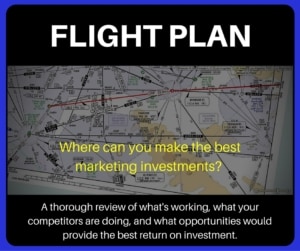
Marketing, like gardening, is a lot of constant work. but is possible to fail by trying too hard.
While we an safely say that most aviation companies don’t put enough effort into marketing and sales, there are a few companies that have the opposite problem -they’re trying too hard.
My grandpa knows more about gardening and growing things than any other person I’ve ever met. He had an impeccable acre of manicured “farm” in his backyard, with pristine rows of corn, tomatoes, beans and squash.
I used to be his helper. When I was little, he gave me a little plot of my own. I think I had a bean plant and a squash plant and a tomato plant. We carefully started seeds in little brown peat-moss cups and then planted them lovingly in the garden. I watered them every day. I picked every microscopic weed. I watched carefully for every single new leaf and dragged Grandpa over to see it. I moved every little pebble out of the way of their tiny growing root systems. I went into hysterics (as only a five-year-old girl can do) over every bug or worm that strayed into my little territory.
Within the month, every single one of my plants had died.
I couldn’t understand it. I’d worked so hard! It seemed so unfair.
Grandpa told me that in addition to taking good care of plants, you need to “let the plants do some of the work themselves.”
Another thing he said is, “observe more, do less.”
He gave me a whole row of the garden to take care of the following year. And I must say I did much better with it. A whole row kept me so busy that I didn’t have time to fuss over every weed or bug. All I had time for was the basics – watering, fertilizing, and pulling the obvious weeds. I let these plants grow on their own schedule. I didn’t “love them to death.”
So, what does this have to do with marketing?
If you’re finding that promising leads are withering within a few weeks, you could be “loving them to death.”
If you only have a few leads, you may be unknowingly suffocating them, by your actions or even by their perception of your attitude. I get nervous when I’m one of very few customers shopping in a particular store and the salespeople descend, even if they are only being helpful and polite. If there were more customers in the store, I would feel like less of a “target” even if the salespeople are equally friendly and say exactly the same things.
Your customers may feel the same way. If they perceive they’re the only quarry within miles of your sales staff, they get nervous. Prospects are fantastic at perceiving their own importance to a salesperson’s objectives. The anxiety of a desperate salesperson will make them uncomfortable, even if the salesperson does everything right and even if the prospect can’t quite articulate what the problem is. They smell desperation from miles away.
The remedy?
Plant a bigger field. Build a bigger pipeline. Get more leads for your sales staff to work with so they don’t have time to worry about every little detail. Automate some of the steps so that customers can “grow at their own speed” and express interest and/or find out more on their own.
Think of it as a dance – you take one step forward, they take one small step forward. Don’t be the one doing all the pursuing.
For long-cycle, large-ticket sales, this is a list of steps to use as examples.
While there is not a direct one-to-one correlation between these steps, you can roughly expect steps at the top of the list are most appropriate for early in the relationship when there is less commitment on both sides. Steps further down the list are most appropriate later in the relationship after there is more commitment on both sides.
Human relationships, including sales relationships, are never precisely balanced or perfectly ordered, but you should have a fairly even ratio of actions taken by either side.
| Your Company Might Do This |
Prospective Customers Might Do This |
|
|
Waiting for prospects to take the next step themselves is equivalent to my Grandpa’s advice to “let them do some of the work themselves.” They have a better sense of what they need and can sometimes serve their own needs without our invasive meddling.
Judging when it’s appropriate to move to the next step is more art than science. Experienced salespeople who are able to “read” a client’s signals better can move forward more confidently. Newer salespeople should move more carefully through these steps.
We use sophisticated lead scoring software to determine when many of the actions above take place – an aggregate lead score is based on the number of emails a prospect opens, the number of links in our website they click, and other specific actions like downloading ebooks or watching movies.
 This lead scoring technique helps us target the prospects that want and need our attention, so that we spend our time wisely rather than bothering folks that aren’t as interested or aren’t ready to hear from us yet. This helps us “observe more, and do less.”
This lead scoring technique helps us target the prospects that want and need our attention, so that we spend our time wisely rather than bothering folks that aren’t as interested or aren’t ready to hear from us yet. This helps us “observe more, and do less.”
Just as important as moving forward at the right speed – it’s also wrong to backtrack. Asking for too little ruins your credibility and the prospect’s confidence in the process. If you’ve already delivered a formal sales presentation, don’t offer to to follow up with another informal meeting or send another generic brochure. Ask specifically what’s needed to move forward with the purchase decision (one way or the other.
What I learned from my Grandpa about gardening holds true in marketing – you have to let prospects do some of the work themselves! You also need to observe more and do less. And it’s easier to do that when you’re looking out over a whole field of prospects than if you have sales goals to meet this month and only one or two names on your prospect list.
Need help expanding your “field” of prospects or want to talk about how lead scoring can help improve your targeting?
Find 30 minutes on my calendar that’s convenient for you, and let’s talk about how ABCI can help..






Leave A Comment